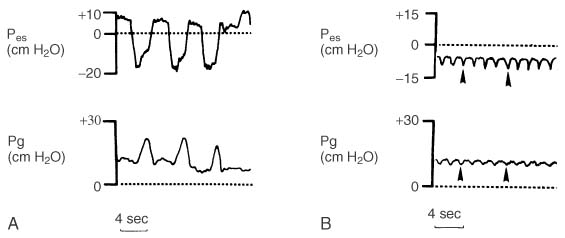Figure 36-21
Examples of transdiaphragmatic pressure monitoring.
A, Simultaneous esophageal and gastric pressure waveforms
during tidal breathing in a normal individual. Negative esophageal (and therefore
pleural) pressure swings are accompanied by positive gastric pressure waves, indicating
the development of transdiaphragmatic pressure during inspiration. B,
The same waveforms in a patient with phrenic nerve palsy (and therefore absent diaphragmatic
contraction). Negative intrathoracic pressure swings (arrowheads)
are accompanied by gastric pressure swings in the same direction. Intrathoracic
pressure changes are directly transmitted through a passive diaphragm. These changes
can also be observed in the early postoperative period in patients who have had upper
abdominal surgery. (From Brown KA, Hoffstein V, Byrick RJ: Bedside diagnosis
of bilateral diaphragmatic paralysis in a ventilator-dependent patient after open-heart
surgery. Anesth Analg 64:1208, 1985.)

